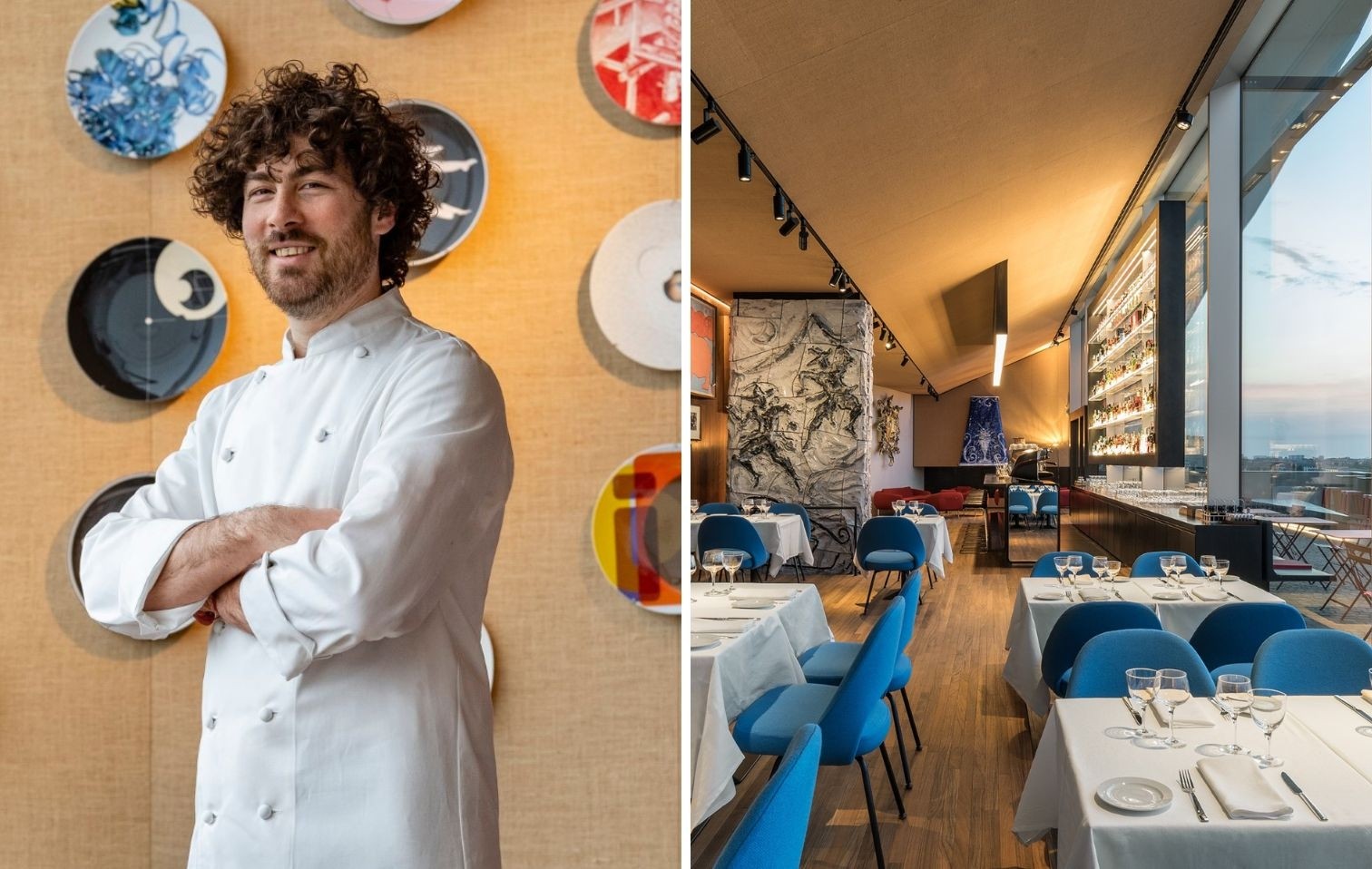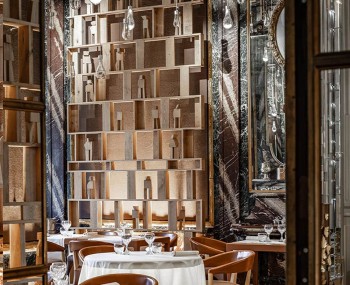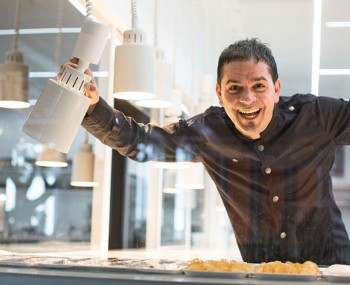Chef Lorenzo Lunghi amazes with disarming, instinctive cuisine; the building and countless artistic riches do the rest. The Prada Foundation Torre among works of design, breathtaking views and dishes that leave an impression.
Photos: Credits Torre Fondazione Prada
The building
Crossing the courtyard from Fondazione Prada, with the sun glinting off the two hundred thousand gold leaves with which the Haunted House is covered, as one reaches Torre, in its magnetic asymmetry with floor heights ranging from 3 to 8 meters, one cannot help but think of when Miuccia Prada declared to The New York Times her attraction to the "ugly." That at first glance creates an inevitable short-circuit, but then analyzing well what the designer said, one fully understands that her aversion is to a bourgeois idea of beauty, to a canonical aesthetic.

Much more interesting to investigate the opposite, which by lexicography is called ugliness, but in practice it is always something that generates fascination. In his apologia for ugliness, the German philosopher Karl Rosenkranz, in the mid-nineteenth century, argued that anything that is asymmetrical, distorted, dissimilar to the mainstream always arouses an attractive aesthetic interest. Here, after all, we are dealing with a maison that has recoded the unconventional as a new paradigm of beauty, offering a novel perspective on aesthetics with a very high rate of avant-garde. The Torre, designed by Rem Koolhaas with Chris van Duijn and Federico Pompignoli of the OMA studio, is the apotheosis of geometric heterogeneity; the trapezoidal base develops into several rectangular planes; on the main side, large triangles protrude like cutouts in the facade.

We walk the sixty meters of the building on a glass elevator that for an optical effect seems to move at an angle, completely covered in backlit pink onyx, and after passing the floors that house Atlas, the permanent Prada Collection curated by Germano Celant, we reach the Torre restaurant, on the sixth floor. The welcome by the ladies at the reception, in total black Prada outfits, with sandals and socks, is one of refined algidity. Attention is drawn first and foremost by the monumental bottle rack suspended behind the bar counter and, immediately after, by the Milan skyline printed on the huge windows. Where even the Madonnina del Duomo stands out.

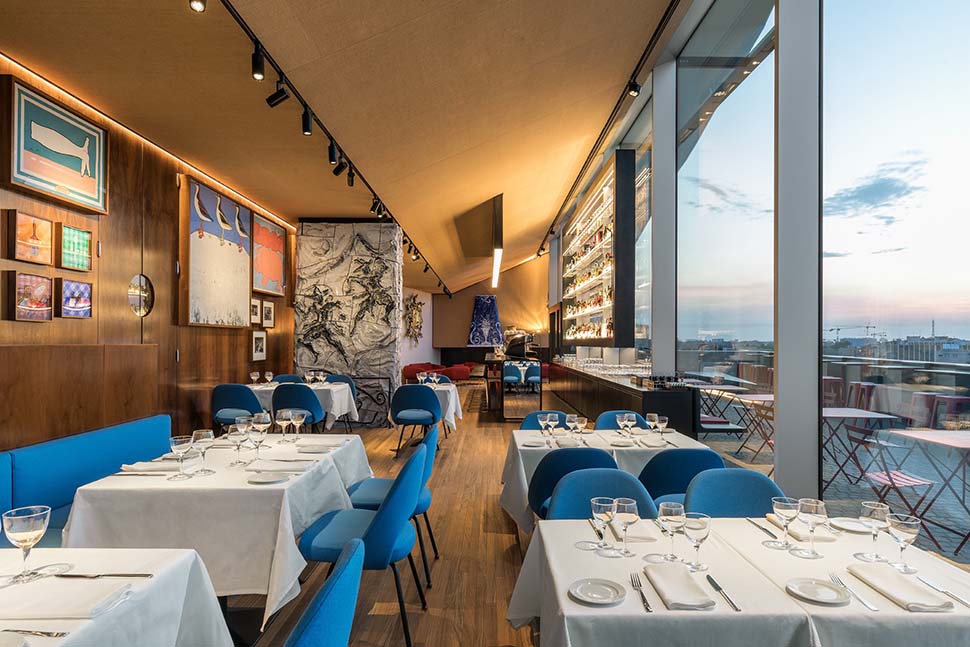
Many artworks, such as Jeff Koons' blow-ups of 1980s advertisements, or the fireplace mantle, Lucio Fontana's Jellyfish Head, and historic design pieces, lend the bar area an elegantly retro intimacy. From the mixing area, from the cocktail menu inspired by the seven chakras, come Suono - gin, hibiscus, bergamot, tio pepper sherry, pineapple, ginger - and Terra - Scottish gin, mezcal, beet, lavender; plenty of freshness with a measured alcoholic coté to slightly electrify. To nibble on while sipping, red legume and potato pakora sprinkled with paprika; vol-au-vent with blueberry and apricot sauce; spinach and ricotta stuffed dumpling.


The restaurant
The restaurant, opened in 2018, is laid out along the full length of the window, the style evoking the ultra-sophisticated atmospheres of that masterpiece of collective aesthetics that is Playtime, Jacques Tati's cult film. Even more, the fascinating elevated space, occupied by the original furnishings of the Four Seasons Restaurant in New York designed by Philip Johnson in 1958, complemented by some elements of Carsten Höller's installation The Double Club. A total of more than eighty seats, plus twenty on the triangular terrace from which an incredibly radiant Milan is revealed at sunset.

One of the walls is covered with artist's plates, donated by Elmgreen & Dragset, Thomas Demand, Mariko Mori, among others, sort of "art edition" Buon Ricordo plates. For those seeking a totally private corner, on the upper floor is the room with a terrace dedicated to the chef's table, overlooking the kitchen, a sienna velvet paneling and an exclusive set of 19th-century Chinese chairs of rare wonder.
The Chef
And into this phantasmagorical aesthetic meltin' pot is grafted the work of Chef Lorenzo Lunghi, a 37-year-old Florentine, at the helm of Torre's kitchen for four years, and the previous ones committed to building a distinguished resume. Beginning at a very young age with one of the masters who made the history of other Italian cuisine as Fulvio Pierangelini, continuing with his son Fulvietto at Bucaniere in San Vincenzo, Livorno, before leaving for Paris, where he was captivated by the whimsy of Iñaki Aizpitarte, a pioneer of French bistronomy, and joined him at both Le Chateaubriand and Le Dauphin. Until he stayed for five years at Saturne, where he served as sous chef to Sven Chartier.
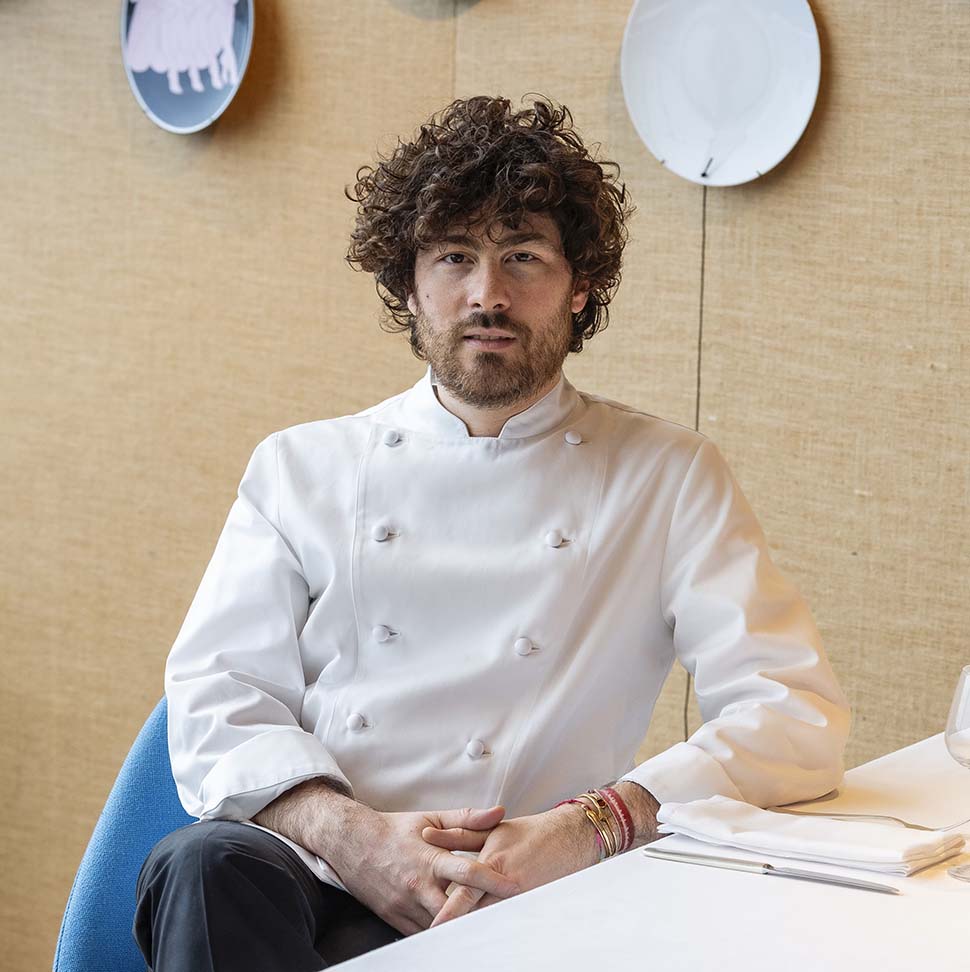
It is a solid background that Lunghi reworks through the filter of his eclectic personality, but above all his spontaneity. For as with Prada's poetics, the Chef categorically eschews the more bourgeois, and sometimes stale, conception of haute cuisine, in the artificiality of, for example, the throngs of amuse bouche, or the convulsive posing to the tune of tweezers of flowers and miniatures to decorate dishes. In favor of elegant substance, where technique blends with compelling ideas and spontaneous creativity. And without wishing to rise to the role of haute cuisine theoreticians, we may say that this is precisely the direction to take these days. Dubuffet, father of Art Brut, and here we return to the initial question of what is beautiful and what is ugly, said that spontaneous artistic expressions, far from convention and conditioning, are demonstrations of aesthetic purity and beautiful simplicity.
The cuisine
Chef Lunghi 's signature comes very close to this definition, which connects congenial to Prada's philosophy. And it manifests itself from the very beginning of the menu with a tartlet, composed of onions, trombetta zucchini, broccoli, pistachio and a grating of smoked ricotta, which together with a pan brioche with veal battuta, paprika mayonnaise and pepper represents the welcome of the Chef's free-hand path.

Conceived with a great sense of ethics and salvaging, so the fish of the day, the snapper, is processed in its integrity and we find it in three dishes. Dipped in a cold consommé, with fresh walnuts punctuating the bitterness, and the cherries and tomatoes sweetening with a few acidic flashes. To be plumped up with a potato flatbread even more impudent when dipped in whipped bear-garlic butter.


Along with bread made from semi-whole wheat flour and sourdough comes 100% Leccino oil from the Bertelli family's olive groves in Arezzo. Full-bitten white asparagus is barbecued, wrapped in a chamomile whipped butter and mouthwateringly plumped with a scamorza and citron sauce.


The snapper, again raw, blends with the creaminess of Borlotti beans, with the lard adding roundness and comfort. A decisive delicacy that of the fennel cream that seasons the twine and gains flavor with roe and smoked ricotta.


Also in the spirit of recuperation, the snapper collar is cooked in a copper pan with gobbetti and Maremma-style pickles, and thus arrives at the table, to be shared in all its succulence. Primordial cooking for the pigeon, barbecued along with a Tropea onion and fig, with a quenelle of yuzu compote to close the scale of sweet tones.


Verbena ice cream with yogurt and oregano serves as the perfect link between the savory courses and dessert; a yuzu cooked cream, sesame ice cream, puffed sesame, pollen, and honeycomb.


Contacts
La Torre Fondazione Prada
Address: Via Giovanni Lorenzini, 14, 20139 Milano MI
Phone: 02 2332 3910
